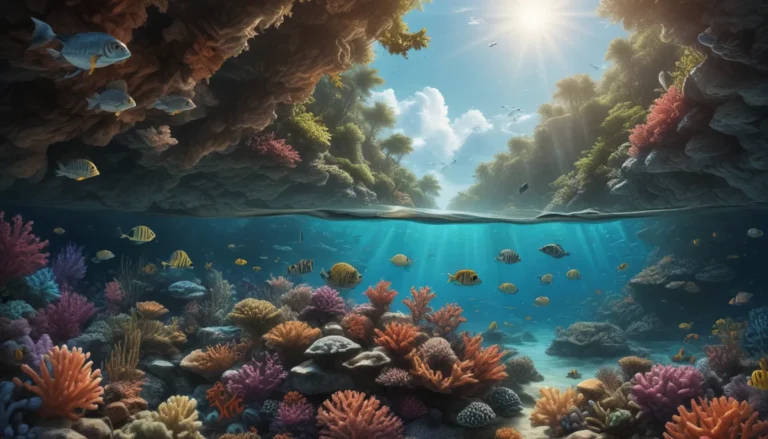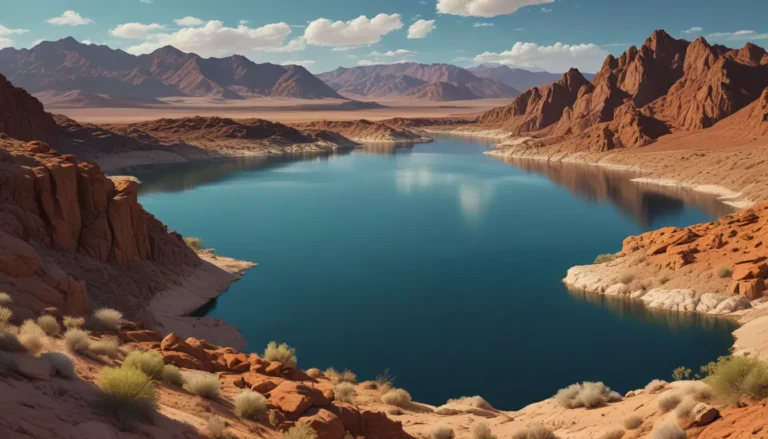The pictures we use in our articles might not show exactly what the words say. We choose these pictures to make you interested in reading more. The pictures work together with the words but don’t take their place. The words still tell you the important facts.
Welcome to the wondrous world of the Southern Ocean, a vast and mysterious body of water that encircles Antarctica. Often referred to as the "forgotten ocean," this enigmatic region is brimming with surprising facts and unique wonders waiting to be explored. Join us on a journey as we delve into the depths of knowledge about the Southern Ocean, uncovering 15 fascinating and unexpected facts that will leave you in awe of this incredible part of our planet. So strap on your virtual snorkel and get ready to dive into the captivating world of the Southern Ocean!
The Unique Southern Ocean
The Southern Ocean, also known as the Antarctic Ocean, stands out as a distinctive body of water that surrounds Antarctica. As the newest and fifth-largest ocean in the world, covering an expansive area of about 20 million square kilometers, the Southern Ocean boasts a strong circumpolar current that sets it apart both geographically and ecologically.
The Icy Realm
Renowned for its icy temperatures, the Southern Ocean holds the title of the coldest ocean on Earth. With an average surface water temperature of around -2 degrees Celsius (28 degrees Fahrenheit), this frigid environment gives rise to massive icebergs and fosters unique marine ecosystems found exclusively in the Southern Ocean.
The Diverse Wildlife Haven
Home to a diverse array of marine wildlife, the Southern Ocean is a sanctuary for species that cannot be found anywhere else on our planet. From the iconic Antarctic krill and regal Emperor penguins to the enchanting Weddell seals, the icy waters and ice-covered shores of the Southern Ocean teem with rich biodiversity, making it a vital area for scientific research and conservation efforts.
Delving into Currents and Circumpolarity
The Southern Ocean is characterized by the powerful Antarctic Circumpolar Current (ACC), a continuous and robust current that flows from west to east, encircling the entire continent of Antarctica. One of the strongest ocean currents globally, the ACC reaches speeds of up to 4 knots, shaping the unique dynamics of the Southern Ocean.
Unveiling Underwater Marvels
Beneath the surface of the Southern Ocean, a world of intriguing underwater features awaits discovery. From the world's largest underwater mountain range, the Mid-Atlantic Ridge, to the deepest part of the ocean, the Challenger Deep, which plummets to approximately 7,235 meters (23,737 feet), the Southern Ocean's seabed is a treasure trove of geological wonders.
The Climate Regulator
Playing a pivotal role in global climate regulation, the Southern Ocean acts as a vital carbon sink, absorbing a significant amount of carbon dioxide from the atmosphere. This crucial function helps mitigate the impacts of climate change by reducing greenhouse gas concentrations, while also influencing oceanic and atmospheric circulation that shapes weather patterns and climates worldwide.
Nurturing Exploration and Discovery
With a rich history of exploration and discovery, the Southern Ocean has captivated the hearts of adventurers and scientists alike for centuries. From Captain James Cook's pioneering voyage across the Antarctic Circle in 1773 to modern-day scientific expeditions unraveling the ocean's mysteries, the Southern Ocean continues to be a beacon of exploration and scientific inquiry.
The Sanctuary of Protection
In a landmark move to safeguard the fragile ecosystem of the Southern Ocean, the world's largest marine protected area was established in 2016. Encompassing 1.55 million square kilometers, this sanctuary serves as a refuge for the diverse marine life within the Southern Ocean, ensuring the preservation of its pristine beauty for generations to come.
The Majestic Icebergs
Famous for its spectacular icebergs, the Southern Ocean showcases towering icy formations that break off from glaciers and drift freely across its waters. Ranging in shapes and sizes, some icebergs soar several hundred meters above the ocean's surface, providing vital habitats for marine species and standing as breathtaking natural wonders.
Confronting Climate Challenges
The extreme climate conditions of the Southern Ocean pose significant challenges for human exploration and scientific research. Harsh weather, fierce winds, and freezing temperatures create a formidable environment for those venturing into this region. Despite these challenges, scientists and explorers persevere in uncovering the secrets of the Southern Ocean.
The Wellspring of Nutrient-Rich Waters
A major source of nutrient-rich waters, the Southern Ocean's upwelling of deep, nutrient-rich waters nourishes marine ecosystems worldwide. Sustaining the growth of phytoplankton, the foundation of the ocean's food chain, these microscopic organisms play a crucial role in supporting the abundance of marine life in the Southern Ocean and beyond.
Exploring Oceanic Depths
Boasting impressive oceanic depths, the Southern Ocean harbors vast areas exceeding 4,000 meters (13,000 feet) in depth. The interplay of deep waters and unique ocean currents creates an ideal environment for the flourishing of rich marine ecosystems, offering valuable insights into the geological processes shaping our planet.
The Evolution of Boundaries
The boundaries of the Southern Ocean have evolved over time, with the International Hydrographic Organization officially recognizing it as a distinct ocean in 2000, separate from the Atlantic, Indian, Pacific, and Arctic Oceans. This acknowledgment emphasizes the unique characteristics and significance of this enigmatic body of water.
Facing Climate Change
Particularly vulnerable to the impacts of climate change, the Southern Ocean grapples with rising temperatures and melting ice that threaten the delicate balance of its ecosystem and the species dependent on it. Understanding the effects of global warming on the Southern Ocean is critical for implementing effective conservation strategies and mitigating further damage.
Embracing Endless Discoveries
Continuing to enchant scientists, explorers, and nature enthusiasts, the Southern Ocean beckons with its untouched beauty and hidden treasures. As research and exploration advance, new discoveries about this remote and awe-inspiring ocean emerge, reinforcing its role as a beacon of mystery and a testament to the wonders of our planet.
Embarking on the Southern Ocean Journey
The Southern Ocean stands as an awe-inspiring and enigmatic realm on our planet, captivating with its unique features and fascinating ecosystem. From climate regulation to diverse marine life, the Southern Ocean offers a myriad of surprises waiting to be unraveled.
As boundaries shift and scientific understanding deepens, the exploration of the Southern Ocean continues to provide valuable insights into its global significance. Whether you're a curious traveler, a dedicated researcher, or simply someone intrigued by our world's mysteries, delving into the wonders of the Southern Ocean promises an unforgettable experience filled with beauty, vastness, and scientific marvels.
Conclusion: Unveiling the Mysteries of the Southern Ocean
In conclusion, the Southern Ocean stands as a captivating and extraordinary part of our world, brimming with unique wonders and scientific significance. From its icy depths to its vibrant marine life, the Southern Ocean offers a glimpse into the complexities and marvels of our planet.
As we navigate the evolving boundaries and environmental challenges of the Southern Ocean, our collective understanding and appreciation for this enigmatic region continue to grow. Let us embrace the endless discoveries that await in the Southern Ocean, fostering a deeper connection to the awe-inspiring beauty and scientific importance of this remarkable part of our planet.
FAQs About the Southern Ocean
Q: Where is the Southern Ocean located?
A: The Southern Ocean surrounds Antarctica, extending from the coastlines of Antarctica to 60 degrees south latitude.
Q: How is the Southern Ocean different from other oceans?
A: The Southern Ocean stands out due to its strong circumpolar current, colder water temperatures, and unique marine life adapted to its specific conditions.
Q: What marine life can be found in the Southern Ocean?
A: The Southern Ocean hosts a variety of marine species, including seals, whales, penguins, fish, and a diverse range of plankton and microscopic organisms.
Q: What is the role of the Southern Ocean in regulating the Earth’s climate?
A: The Southern Ocean plays a pivotal role in the global climate system by absorbing carbon dioxide, influencing ocean currents, and shaping weather patterns worldwide.
Q: Are there any conservation efforts in place for the Southern Ocean?
A: Yes, international agreements such as the Antarctic Treaty System and the Convention for the Conservation of Antarctic Marine Living Resources aim to protect the Southern Ocean and its unique ecosystem through sustainable practices and conservation measures.
Q: Can I visit the Southern Ocean?
A: While direct visits to the Southern Ocean may be challenging for most people, opportunities exist to explore its surrounding regions through expedition cruises to Antarctica. Careful planning and adherence to environmental guidelines are essential for these trips.
As we unravel the captivating facts of the Southern Ocean, let your curiosity lead you to discover the unique characteristics and behaviors of hourglass dolphins, the intriguing ecosystem and history of Ross Sea, and the stunning pink hues of Lake Hillier. Each adventure promises an exploration of the surreal and the scientific wonders that await your discovery.
I hope you found this guide to the Southern Ocean enlightening and inspiring. Let's continue our journey of exploration and discovery, celebrating the marvels of our planet's most enigmatic corners.






